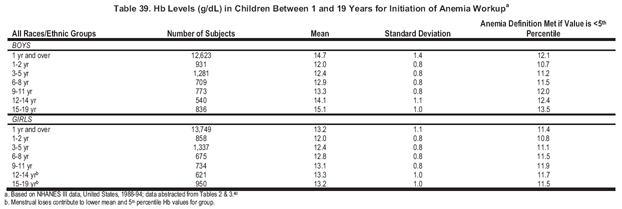
Identifying anemia is the first step in evaluating the prognostic, diagnostic, and therapeutic significance of anemia in patients with CKD.
1.1.1 Stage and cause of CKD: (FULLY APPLICABLE TO CHILDREN)
In the opinion of the Work Group, Hb testing should be carried out in all patients with CKD, regardless of stage or cause.
1.1.2 Frequency of testing for anemia: (FULLY APPLICABLE TO CHILDREN)
In the opinion of the Work Group, Hb levels should be measured at least annually.
1.1.3 Diagnosis of anemia: (APPLICABLE TO CHILDREN, BUT NEEDS MODIFICATION)
ADULT CPR
In the opinion of the Work Group, diagnosis of anemia should be made and further evaluation should be undertaken at the following Hb concentrations:
• <13.5 g/dL in adult males.
• <12.0 g/dL in adult females.
PEDIATRIC CPR
In the opinion of the Work Group, in the pediatric patient, diagnosis of anemia should be made and further evaluation should be undertaken whenever the observed Hb concentration is less than the fifth percentile of normal when adjusted for age and sex.
Stage and Cause of CKD
There is no evidence in the pediatric CKD population to contradict the principles as outlined in the Adult Guideline 1.1 with respect to the use of Hb level, not Hct, to define anemia and the value of obtaining this at a standard time (eg, before dialysis during the midweek run) in patients on HD therapy.
It also is clear that children with CKD are more likely to develop anemia as their renal function decreases. From USRDS 2004 data, we know that the mean eGFR at initiation of dialysis therapy in children is 10.3 mL/min/1.73 m2 and that, at this point, 35% to 40% of children are already receiving ESA therapy.28 One study of 35 children with various degrees of renal disease examined the role of erythropoietin and potential inhibitors of its action. The study suggested that in this group, the risk for anemia increased at a GFR less than 35 mL/min/1.73 m2.302 Unfortunately, unlike the adult literature, there is no better direct or observational evidence that clearly delineates a particular cutoff level of function for which the risk for CKD-associated anemia increases significantly in children.
Frequency of Testing for Anemia
This guideline is considered applicable to children because there is no direct evidence to support a different recommendation. However, it is often the case that children (especially younger ones) will receive more frequent laboratory monitoring of their CKD status caused, in part, by expected changes in values during growth.
Diagnosis of Anemia
In terms of defining a lower limit of “normal” Hb level before initiating a workup for anemia in a child with CKD, it seems reasonable to apply the same approach, although not the same values, as in the adult Guidelines. In other words, anemia in a child with CKD should be diagnosed and evaluated at such time that the child's Hb level decreases to less than the fifth percentile for their age and sex. Adjustment in normal Hb levels—and hence the definition of anemia—for children living at higher altitudes likely is reasonable, as in the adult Guidelines, although age-specific pediatric data are not available.
The normative values for this definition in children older than 1 year of age have been taken from the NHANES III reference data, as in adults (Table 39), whereas the values for children from birth to 1 year are taken from data compiled elsewhere (Table 40). 303